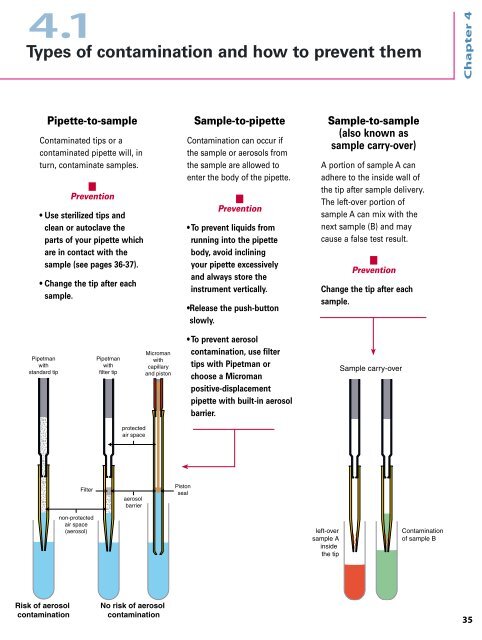Gilson guide to pipetting - Emidio Albertini
Gilson guide to pipetting - Emidio Albertini
Gilson guide to pipetting - Emidio Albertini
You also want an ePaper? Increase the reach of your titles
YUMPU automatically turns print PDFs into web optimized ePapers that Google loves.
4 .1<br />
Types of contamination and how <strong>to</strong> prevent them<br />
Pipette-<strong>to</strong>-sample<br />
Contaminated tips or a<br />
contaminated pipette will, in<br />
turn, contaminate samples.<br />
n<br />
Prevention<br />
• Use sterilized tips and<br />
clean or au<strong>to</strong>clave the<br />
parts of your pipette which<br />
are in contact with the<br />
sample (see pages 36-37).<br />
• Change the tip after each<br />
sample.<br />
Pipetman<br />
with<br />
standard tip<br />
Risk of aerosol<br />
contamination<br />
Filter<br />
non-protected<br />
air space<br />
(aerosol)<br />
Pipetman<br />
with<br />
filter tip<br />
protected<br />
air space<br />
aerosol<br />
barrier<br />
Microman<br />
with<br />
capillary<br />
and pis<strong>to</strong>n<br />
No risk of aerosol<br />
contamination<br />
Pis<strong>to</strong>n<br />
seal<br />
Sample-<strong>to</strong>-pipette<br />
Contamination can occur if<br />
the sample or aerosols from<br />
the sample are allowed <strong>to</strong><br />
enter the body of the pipette.<br />
n<br />
Prevention<br />
• To prevent liquids from<br />
running in<strong>to</strong> the pipette<br />
body, avoid inclining<br />
your pipette excessively<br />
and always s<strong>to</strong>re the<br />
instrument vertically.<br />
• Release the push-but<strong>to</strong>n<br />
slowly.<br />
• To prevent aerosol<br />
contamination, use filter<br />
tips with Pipetman or<br />
choose a Microman<br />
positive-displacement<br />
pipette with built-in aerosol<br />
barrier.<br />
Sample-<strong>to</strong>-sample<br />
(also known as<br />
sample carry-over)<br />
A portion of sample A can<br />
adhere <strong>to</strong> the inside wall of<br />
the tip after sample delivery.<br />
The left-over portion of<br />
sample A can mix with the<br />
next sample (B) and may<br />
cause a false test result.<br />
n<br />
Prevention<br />
Change the tip after each<br />
sample.<br />
left-over<br />
sample A<br />
inside<br />
the tip<br />
Sample carry-over<br />
Contamination<br />
of sample B<br />
Chapter 4<br />
35








